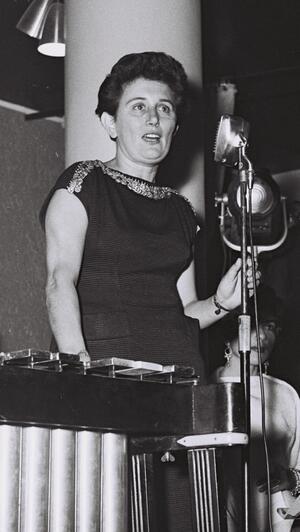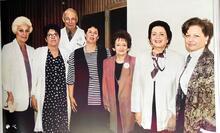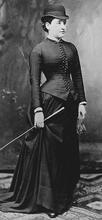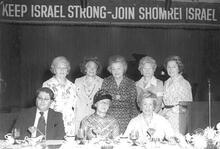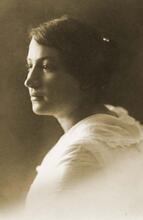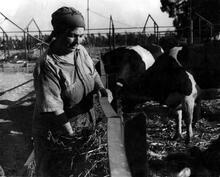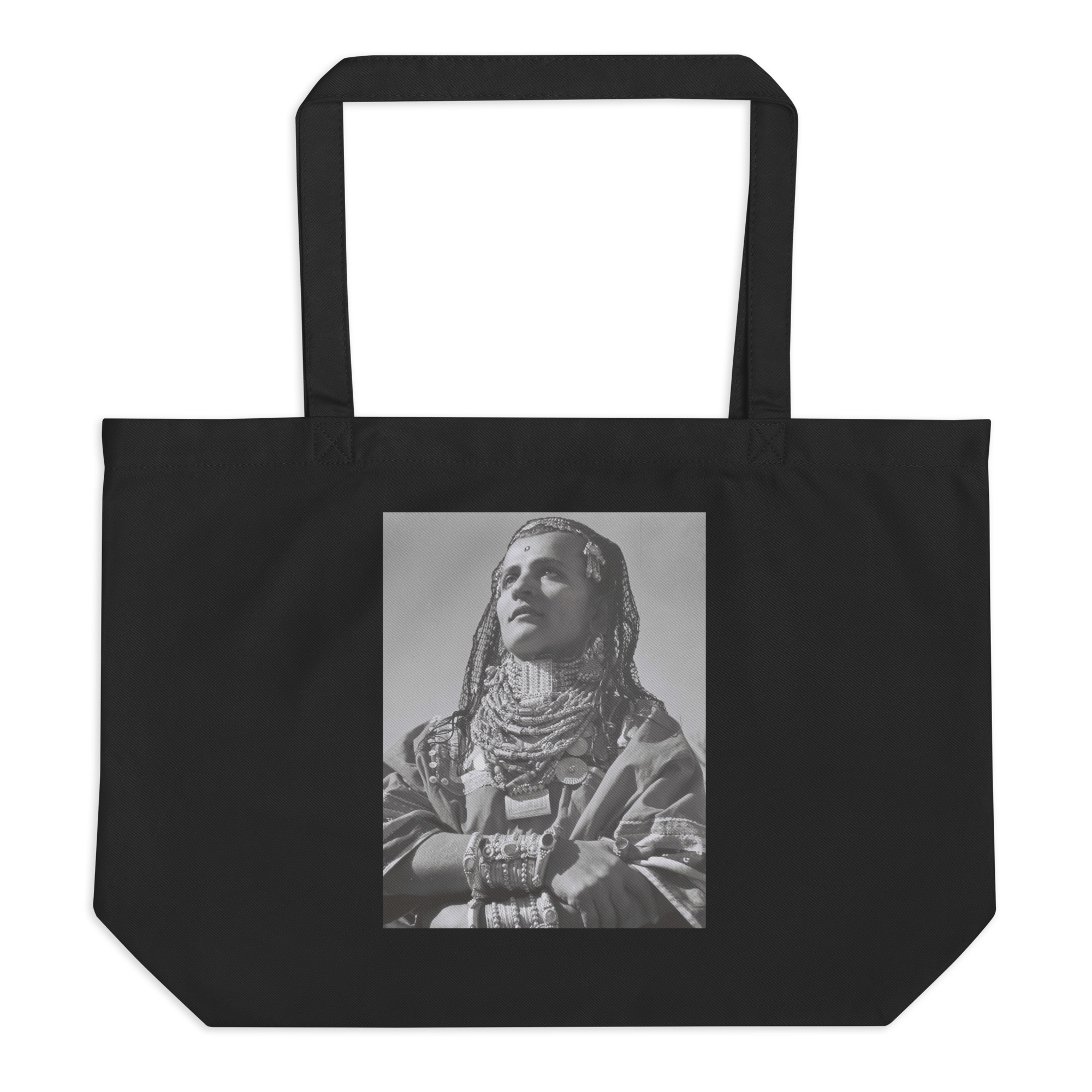Ruth Dayan
Israeli activist Ruth Dayan, 1955. From the National Photo Collection of Israel. Via Wikimedia Commons.
Born in Haifa during the last years of Ottoman rule, Ruth Dayan came of age in a household steeped in justice and socialist-Zionist ideals. She married Moshe Dayan, the man who would become Israel’s most famous general, but she built a life that was entirely her own. In the 1950s, she worked with Jewish immigrants from Yemen and North Africa, helping them find a place in a society that barely knew how to welcome them. She founded Maskit, a fashion house that stitched together the country’s many cultures, preserving traditions others were ready to discard. Later, she became a sharp critic of Israeli policy and a tenacious ally to Palestinian activists and Arab intellectuals. She believed empathy could change the world—and it often did.
Family and Early Life
Ruth [Schwartz] Dayan was born on March 6, 1917, in Haifa, then under Ottoman rule, to pioneering Russian-Jewish immigrants who embodied the socialist-Zionist ideals of the time. Her father, Tzvi, was a lawyer and her mother, Rachel, was a feminist and trailblazer who became the first woman in Palestine to earn a driver’s license—a reflection of the bold and independent spirit Ruth would inherit.
In 1923, the Schwartz family moved to London, where Ruth’s parents studied at the London School of Economics under Sidney and Beatrice Webb, the formidable husband-and-wife team who helped lay the foundations of British socialism.
Returning to Mandatory Palestine six years later with her parents and baby sister Reuma (born 1925, later married to Ezra Weizman), the family settled in Jerusalem. Ruth’s early years were shaped by the region’s political upheaval and by the ideals of social justice her parents instilled. She never took to the classroom. What she longed for was life on a socialist A voluntary collective community, mainly agricultural, in which there is no private wealth and which is responsible for all the needs of its members and their families.kibbutz, where the pioneers of Zion were building a new society from the ground up.
At eighteen, Ruth joined the Cooperative smallholder's village in Erez Israel combining some of the features of both cooperative and private farming.moshav (cooperative farming village) Nahalal, where she met Moshe Dayan, a rising star in the Haganah, the main Zionist paramilitary organization. They married soon after in 1935 and raised three children, Yael, Assi, and Udi, while living a spartan pioneer life. Moshe’s military career—first as a commander in the Haganah during the War of Independence in 1948, later as chief of staff during Israel’s early wars—often left Ruth as the de facto head of the household, navigating the challenges of rural life with resilience and independence.
Working With Migrants
In the early 1950s, as waves of Jewish immigrants from Yemen, North Africa, and Eastern Europe arrived in Israel, Dayan began working in immigrant villages, teaching domestic skills and farming. However, she quickly recognized that survival required more than skills—it demanded systemic change. Many immigrants, living in tent camps in the Negev, lacked even basic necessities, and Dayan dedicated herself to helping them build meaningful lives. Her advocacy extended to marginalized communities across the spectrum, eventually including Bedouins and Arab citizens of Israel. She believed that fostering dignity and economic opportunity was key to building a just society.
Maskit
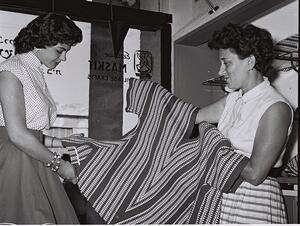
Ruth Dayan, right, showing a hand-made blouse to Israel’s newly elected beauty queen Sarah Tal at the Maskit shop in Tel Aviv, June 14, 1956. Photograph by Hans Pinn. From the National Photo Collection of the State of Israel. Via Wikimedia Commons.
In 1954, Dayan founded Maskit, a government-sponsored initiative to preserve and promote traditional crafts. Inspired by the artistry of immigrant women from Bulgaria and Romania and Arab artisans, she turned local craftsmanship into a source of income and cultural pride. Maskit’s designs fused ethnic traditions from Eastern Europe, Yemen, Egypt, and Libya with modern aesthetics—eventually becoming a global phenomenon.
With Hungarian-born designer Finy Leitersdorf, Dayan transformed Maskit into a symbol of "Israeliness," drawing on the hues of the desert and the Mediterranean. A nation made up of people from a hundred countries began to have its own distinctive style. The brand’s iconic Desert Coat was famously worn by Audrey Hepburn, and Maskit collaborated with fashion houses like Dior and Yves Saint Laurent. Beyond fashion, Maskit reflected Dayan’s vision of coexistence, employing artisans from over 20 communities, including Syrian weavers and Arab silversmiths. Though Maskit closed for financial reasons in 1994, it was revived decades later.
Dialogue and Coexistence
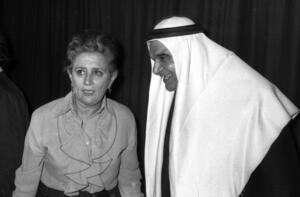
Israeli activist Ruth Dayan and deputy Communication Minister Jaber Muadi, at the opening of a pioneering showing of works by seven Arab painters from Israel and the West Bank, May 16, 1972. From the Dan Hadani collection, National Library of Israel, Pritzker Family National Photography Collection. Via Wikimedia Commons.
Ruth divorced Moshe Dayan in 1971, citing his infidelities and other growing differences about lifestyle; he had developed a taste for the high life she couldn’t accept. This chapter in her life marked her emergence as an independent figure in Israeli society. Her children followed creative and political paths: Yael became a writer and politician, Assi a celebrated actor and filmmaker, and Udi a sculptor.
For Ruth’s part, her divorce permitted her to speak and act more freely about the Israeli-Palestinian conflict. Dayan’s commitment to peace transcended politics. She co-founded Brit Bnei Shem, a Jewish-Arab social group, and formed close ties with Palestinian activists such as Raymonda Tawil, whose daughter married Yasser Arafat. Despite the often-bleak political landscape, Dayan believed in the transformative power of personal relationships to build bridges. “Nothing will stop terrorism except dialogue,” she asserted to the Israeli journalist Gideon Levy (Levy 2010). In 2009, she supported B’Tselem, a human rights organization advocating for Palestinians, and publicly condemned the Israeli occupation of Gaza and the West Bank as “untenable and abhorrent.” She envisioned a future of coexistence through a two-state solution, rooted in justice and mutual respect.
Dayan received numerous honors, including the Partner of Peace Award (2007) and the President’s Medal of Distinction.
Though skeptical of political leaders, Dayan remained hopeful for Israel’s moral and political renewal. She lamented that Zionism had not fully realized its ideals but maintained a romantic vision of what Israel could become—a nation rooted in freedom, justice, and peace.
Dayan passed away in Tel Aviv on February 5, 2021, at the age of 103, leaving behind a legacy of courage, cultural preservation, and peace-building. Her work with marginalized communities, her fearless critique of injustice, and her unwavering hope for coexistence leave an indelible mark on Israeli history.
Selected Works by Ruth Dayan
National Crafts Among Israelis & Arabs: One Path to Peace. London: Anglo-Israel Association, 1969.
with Helga Dudman. …Or Did I Dream a Dream? The Story of Ruth Dayan. London: Weidenfeld and Nicolson, 1973.
with Wilburt Feinberg. Crafts of Israel. New York: Macmillan, 1974.
David, Anthony. An Improbable Friendship: The Lives of Ruth Dayan and Raymonda Tawil. New York: Arcade Publishing, 2015.
Levy, Gideon. “Moshe Dayan’s Widow: Israel Doesn’t Know How to Make Peace.” Miftah, March 1, 2010, http://www.miftah.org/display.cfm?DocId=21807&CategoryId=5.

